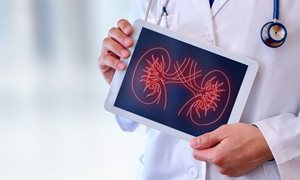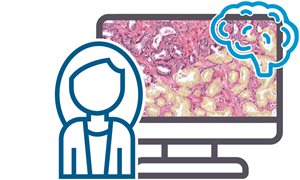9 January 2020
The Nijmegen study, authored by RIHS researchers Wouter Bulten, Geert Litjens and others, has been published in The Lancet Oncology.
Prostate cancer is a frequently occurring type of cancer, but not always aggressive: more men die with prostate cancer than from prostate cancer. However, its treatment has many consequences for the quality of life of patients, so determining aggressiveness is an important step in choosing a treatment. To determine the aggressiveness of the cancer, pieces of tissue (biopsies) are taken from the prostate, which are scored by a pathologist. This ‘Gleason score’ is then used to classify biopsies into five groups – the Gleason Grade Groups – which indicate the risk of dying from prostate cancer. However, this is a subjective process; whether and how a patient is treated may depend on the pathologist who assesses the tissue.
Better than a pathologist
The researchers at Radboudumc developed an AI system that examines those biopsies the same way a pathologist does. The AI system also determines the Gleason score, and then the system can classify a biopt according to the Gleason Grade Groups. By means of deep learning, the system examined thousands of images of biopsies to learn what a healthy prostate is, and what more or less aggressive prostate cancer tissue looks like. Researcher Wouter Bulten describes this process: “The AI system has now been trained with 5759 biopsies from more than 1200 patients. When we compared the performance of the algorithm with that of 15 pathologists from various countries and with differing levels of experience, our system performed better than ten of them and was comparable to highly experienced pathologists.” An additional advantage of such a computer system is that it is consistent and can be used anywhere; the treatment of a patient no longer depends on the pathologist looking at the tissue.
An international competition
As 1.2 million men globally are diagnosed with prostate cancer every year, the development of an AI diagnostic system is interesting for many research groups and companies. “It is advantageous that we are an academic hospital,” says Bulten. “We are close to the patient and the practitioner, and have our own database of biopsies.” As a next step, the Radboudumc team – together with researchers from the Karolinska Institute in Sweden and Kaggle, a subsidiary of Google specialized in data science competitions – wants to hold an international competition in which participants try to beat the Radboudumc algorithm. The insights resulting from this competition will then be used to improve the algorithms.
For more information about the algorithm and to see live examples, visit the website of the pathology group: https://www.computationalpathologygroup.eu/software/automated-gleason-grading/
Background: what is 'deep learning'?
Deep learning is a term used for systems that learn in a way that is similar to how our brain works. It consists of networks of electronic ‘neurons’, each of which learns to recognize one aspect of the desired image. Then it follows the principles of learning by doing, and practice makes perfect. The system is fed more and more images that include relevant information saying – in this case – whether this is cancer or not, and if so, what the Gleason score is. The system then learns to recognize which characteristics belong to cancer, and the more pictures it sees, the better it can recognize those characteristics in undiagnosed images. (We do something similar with small children: we hold up an apple in front of them and say that it is an apple. At a certain point, you don't have to say it anymore.) A major advantage of these systems is also that they learn much faster than humans and can work 24 hours a day.

The Nijmegen study, authored by RIHS researchers Wouter Bulten, Geert Litjens and others, has been published in The Lancet Oncology.
Prostate cancer is a frequently occurring type of cancer, but not always aggressive: more men die with prostate cancer than from prostate cancer. However, its treatment has many consequences for the quality of life of patients, so determining aggressiveness is an important step in choosing a treatment. To determine the aggressiveness of the cancer, pieces of tissue (biopsies) are taken from the prostate, which are scored by a pathologist. This ‘Gleason score’ is then used to classify biopsies into five groups – the Gleason Grade Groups – which indicate the risk of dying from prostate cancer. However, this is a subjective process; whether and how a patient is treated may depend on the pathologist who assesses the tissue.
Better than a pathologist
The researchers at Radboudumc developed an AI system that examines those biopsies the same way a pathologist does. The AI system also determines the Gleason score, and then the system can classify a biopt according to the Gleason Grade Groups. By means of deep learning, the system examined thousands of images of biopsies to learn what a healthy prostate is, and what more or less aggressive prostate cancer tissue looks like. Researcher Wouter Bulten describes this process: “The AI system has now been trained with 5759 biopsies from more than 1200 patients. When we compared the performance of the algorithm with that of 15 pathologists from various countries and with differing levels of experience, our system performed better than ten of them and was comparable to highly experienced pathologists.” An additional advantage of such a computer system is that it is consistent and can be used anywhere; the treatment of a patient no longer depends on the pathologist looking at the tissue.
An international competition
As 1.2 million men globally are diagnosed with prostate cancer every year, the development of an AI diagnostic system is interesting for many research groups and companies. “It is advantageous that we are an academic hospital,” says Bulten. “We are close to the patient and the practitioner, and have our own database of biopsies.” As a next step, the Radboudumc team – together with researchers from the Karolinska Institute in Sweden and Kaggle, a subsidiary of Google specialized in data science competitions – wants to hold an international competition in which participants try to beat the Radboudumc algorithm. The insights resulting from this competition will then be used to improve the algorithms.
For more information about the algorithm and to see live examples, visit the website of the pathology group: https://www.computationalpathologygroup.eu/software/automated-gleason-grading/
Background: what is 'deep learning'?
Deep learning is a term used for systems that learn in a way that is similar to how our brain works. It consists of networks of electronic ‘neurons’, each of which learns to recognize one aspect of the desired image. Then it follows the principles of learning by doing, and practice makes perfect. The system is fed more and more images that include relevant information saying – in this case – whether this is cancer or not, and if so, what the Gleason score is. The system then learns to recognize which characteristics belong to cancer, and the more pictures it sees, the better it can recognize those characteristics in undiagnosed images. (We do something similar with small children: we hold up an apple in front of them and say that it is an apple. At a certain point, you don't have to say it anymore.) A major advantage of these systems is also that they learn much faster than humans and can work 24 hours a day.
Related news items
.aspx?width=800&height=534&ext=.jpg&type=BlockColumn1Zoom1)
Aiosyn and Radboudumc are the first in the Netherlands to implement AI in the clinical pathology workflow Digital pathology slides will be screened with a quality control algorithm
4 April 2022 Aiosyn, a company that develops AI-powered computational pathology analysis for clinical diagnostics, and the department of pathology of Radboudumc, will collaborate to implement an algorithm for quality control of digitized histopathology tissue slides. go to page
Body composition is more important than BMI for renal cancer survival rates
11 January 2022 Body composition is important for survival rates in renal cell cancer. Research from the Radboudumc shows that low muscle quality and low organ fat are associated with poor survival. This involves different stages of renal cancer, ranging from stage I-III to stage IV. go to page
KNAW Early Career Award for Geert Litjens
13 February 2020 Twelve young researchers received the Early Career Award from KNAW on 4 february. One of them is RIHS researcher Geert Litjens. The Award is aimed at researchers in the Netherlands at the start of their career who are capable of developing innovative and original research ideas. go to page
Jelle Barentsz's trilogy of educational papers in European Urology
12 December 2019 Recently, a trilogy of educational papers by our full professor Jelle Barentsz has been published in European Urology. The publications address what urologists need to know about prostate-MRI. go to page

